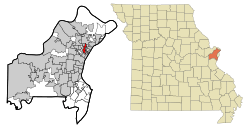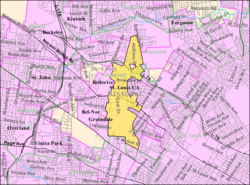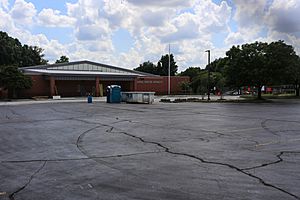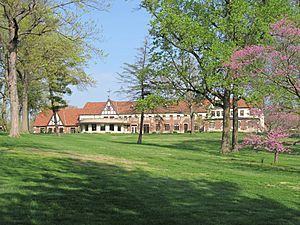Normandy, Missouri facts for kids
Quick facts for kids
Normandy, Missouri
|
|
|---|---|

Welcome sign for Normandy, Missouri, July 2016
|
|

Location of Normandy, Missouri
|
|

U.S. Census Map
|
|
| Country | United States |
| State | Missouri |
| County | St. Louis |
| Area | |
| • Total | 1.85 sq mi (4.80 km2) |
| • Land | 1.85 sq mi (4.80 km2) |
| • Water | 0.00 sq mi (0.00 km2) |
| Elevation | 604 ft (184 m) |
| Population
(2020)
|
|
| • Total | 4,287 |
| • Density | 2,317/sq mi (893.1/km2) |
| Time zone | UTC-6 (Central (CST)) |
| • Summer (DST) | UTC-5 (CDT) |
| FIPS code | 29-52796 |
| GNIS feature ID | 0756450 |
Normandy is a city in St. Louis County, Missouri, United States. The population was 4,287 at the 2020 census.
Contents
History
The town is on land once owned by Charles Lucas. Lucas obtained property from the federal government with land grants, and he purchased the land from victims of the New Madrid earthquake of 1811. He named it for the French coastal region of Normandy from which his father John Baptiste Charles Lucas came. The site of his home is now on the property of Incarnate Word Academy.
Lucas was to fight two duels on Bloody Island with Thomas Hart Benton and died in the 1817 duel.
Upon Charles death, and that of his father, Federal Land Grant Judge J.B.C. Lucas, his land was left to his sister Anne and brother James. Anne married Capt. Theodore Hunt, Son of the Patriot Abraham Hunt of Trenton, N.J., who died in 1832. In 1836 she married Theodore's 1st cousin, the explorer Wilson Price Hunt. The Hunt home at 7717 Natural Bridge Rd. was completed in 1908 after the current site of Glen Echo Club (the old Hunt Estate ) was leased to the Golf Club in 1898 and late sold to the Club. It was used for several years as the convent of the Sisters of the Cenacle before being taken over by the Normandy School District.
Normandy incorporated in May 1945.
In 1960, the Normandy School District approved a bond issue to buy the Bellerive Country Club to form a junior college. In 1963 the Normandy Residence Center became the University of Missouri–St. Louis; the university is partially within the city of Normandy.
In May 1977 Normandy annexed Berdell Hills.
Geography
Normandy is located at 38°42′56″N 90°18′1″W / 38.71556°N 90.30028°W (38.715551, -90.300284).
According to the United States Census Bureau, the city has a total area of 1.85 square miles (4.79 km2), all of it land.
Demographics
| Historical population | |||
|---|---|---|---|
| Census | Pop. | %± | |
| 1880 | 199 | — | |
| 1950 | 2,306 | — | |
| 1960 | 4,452 | 93.1% | |
| 1970 | 6,236 | 40.1% | |
| 1980 | 5,174 | −17.0% | |
| 1990 | 4,480 | −13.4% | |
| 2000 | 5,153 | 15.0% | |
| 2010 | 5,008 | −2.8% | |
| 2020 | 4,287 | −14.4% | |
| U.S. Decennial Census | |||
2020 census
As of the 2020 census, 4,287 people and 2,271 households were living in the city. The racial makeup of the city was 18.2% White, 70.8% African American, 0.3% Native American, 5.7% Asian, 1.2% from other races, and 3.7% from two or more races. Hispanic or Latino of any race were 2.7% of the population.
2010 census
As of the census of 2010, there were 5,008 people, 1,942 households, and 1,023 families living in the city. The population density was 2,707.0 inhabitants per square mile (1,045.2/km2). There were 2,240 housing units at an average density of 1,210.8 per square mile (467.5/km2). The racial makeup of the city was 21.3% White, 69.7% African American, 0.3% Native American, 5.6% Asian, 0.9% from other races, and 2.1% from two or more races. Hispanic or Latino of any race were 1.6% of the population.
There were 1,942 households, of which 31.3% had children under the age of 18 living with them, 20.4% were married couples living together, 27.7% had a female householder with no husband present, 4.6% had a male householder with no wife present, and 47.3% were non-families. 33.6% of all households were made up of individuals, and 4.9% had someone living alone who was 65 years of age or older. The average household size was 2.34 and the average family size was 3.06.
The median age in the city was 26 years. 23% of residents were under the age of 18; 24.7% were between the ages of 18 and 24; 22.9% were from 25 to 44; 21.8% were from 45 to 64; and 7.7% were 65 years of age or older. The gender makeup of the city was 45.8% male and 54.2% female.
Community and Economic Development
Great Streets Projects
In 2014 Normandy approved a Great Streets initiative to redevelop the stretch of Natural Bridge Road between North Hanley and Lucas and Hunt Roads. Construction began in June of that year and was completed in May 2016. Other street revitalization projects in Normandy apart of this initiative included improving the Teardrop and Belwood parks.
Education
Public Education
In July 2014, the Missouri State Board of Education established Normandy Schools Collaborative, formerly the Normandy School District. The Collaborative provides pre-Kindergarten and K-12 education for students in Normandy. The area is served by Normandy High School.
Private Education
Private K-12 schooling is offered at St. Ann Catholic School. St. Ann also operates St. Ann Early Childhood Center.
Higher Education
The University of Missouri - St. Louis is a public university whose campus is partially located within Normandy.
Libraries
The St. Louis County Library operates the Natural Bridge Branch in Normandy.
Public Transportation
MetroLink
MetroLink services are available in Normandy at the UMSL South Station.
Notable people
- Jon Hamm, actor
See also
 In Spanish: Normandy (Misuri) para niños
In Spanish: Normandy (Misuri) para niños



